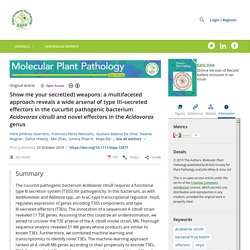

Subtelomeric regions and a repeat-rich chromosome harbor multicopy effector gene clusters with variable conservation in multiple plant pathogenic Colletotrichum species. The birth and death of effectors in rapidly evolving filamentous pathogen genomes. The Pleiades cluster of fungal effector genes inhibit 1 host defenses. Inhibition of jasmonate-mediated plant defences by the fungal metabolite higginsianin B. Show me your secret(ed) weapons: a multifaceted approach reveals a wide arsenal of type III‐secreted effectors in the cucurbit pathogenic bacterium Acidovorax citrulli and novel effectors in the Acidovorax genus - Jiménez-Guerrero - - Molecular Plant Path. Introduction The genus Acidovorax contains a variety of species with different lifestyles.

While some are well adapted to soil and water environments, others have developed intimate relationships with eukaryotic organisms, including as plant pathogens (Rosenberg et al., 2015). Among the latter, Acidovorax citrulli is one of the most important plant pathogenic species (Burdman and Walcott, 2018). This bacterium infects all aerial parts of cucurbit plants, causing bacterial fruit blotch (BFB) disease.
The unavailability of effective tools for managing BFB and the disease’s high destructive potential exacerbate the threat BFB poses to cucurbit production (Burdman and Walcott, 2012; Zhao and Walcott, 2018) yet little is known about basic aspects of A. citrulli–plant interactions. As with many Gram‐negative plant and animal pathogenic bacteria, A. citrulli relies on a functional type III secretion system (T3SS) to promote disease (Bahar and Burdman, 2010). Results Discussion Acknowledgements. A sensor kinase controls turgor-driven plant infection by the rice blast fungus.
Local adaptation drives the diversification of effectors in the fungal wheat pathogen Parastagonospora nodorum in the United States. Abstract Filamentous fungi rapidly evolve in response to environmental selection pressures in part due to their genomic plasticity.

Parastagonospora nodorum, a fungal pathogen of wheat and causal agent of septoria nodorum blotch, responds to selection pressure exerted by its host, influencing the gain, loss, or functional diversification of virulence determinants, known as effector genes. Whole genome resequencing of 197 P. nodorum isolates collected from spring, durum, and winter wheat production regions of the United States enabled the examination of effector diversity and genomic regions under selection specific to geographically discrete populations. 1,026,859 SNPs/InDels were used to identify novel loci, as well as SnToxA and SnTox3 as factors in disease.
Genes displaying presence/absence variation, predicted effector genes, and genes localized on an accessory chromosome had significantly higher pN/pS ratios, indicating a higher rate of sequence evolution. Author summary Results. Deacetylation of chitin oligomers increases virulence in soil-borne fungal pathogens. Effector gene reshuffling involves dispensable mini-chromosomes in the wheat blast fungus. Abstract Newly emerged wheat blast disease is a serious threat to global wheat production.

Wheat blast is caused by a distinct, exceptionally diverse lineage of the fungus causing rice blast disease. Through sequencing a recent field isolate, we report a reference genome that includes seven core chromosomes and mini-chromosome sequences that harbor effector genes normally found on ends of core chromosomes in other strains. No mini-chromosomes were observed in an early field strain, and at least two from another isolate each contain different effector genes and core chromosome end sequences. The mini-chromosome is enriched in transposons occurring most frequently at core chromosome ends.
Author summary The emerging blast disease on wheat is proving even harder to control than the ancient, still-problematic rice blast disease. Editor: Xiaorong Lin, University of Georgia, UNITED STATES. Positively Selected Effector Genes and Their Contribution to Virulence in the Smut Fungus Sporisorium reilianum. We use cookies to enhance your experience on our website.

By clicking 'continue' or by continuing to use our website, you are agreeing to our use of cookies. You can change your cookie settings at any time. We use cookies to enhance your experience on our website.By continuing to use our website, you are agreeing to our use of cookies. You can change your cookie settings at any time. <a href=" Find out more</a> Skip to Main Content. A Phytophthora Effector Suppresses Trans-Kingdom RNAi to Promote Disease Susceptibility. The disease resistance protein SNC1 represses the biogenesis of microRNAs and phased siRNAs.
Genomic signatures of heterokaryosis in the oomycete pathogen Bremia lactucae. Efficient TALEN‐mediated gene editing in wheat - Luo - - Plant Biotechnology Journal. An effector from cotton bollworm oral secretion impairs host plant defense signaling. Rust pathogen effectors: perspectives in resistance breeding. The tomato Pto gene confers resistance to Pseudomonas floridensis, an emergent plant pathogen with just nine type III effectors - Eckshtain‐Levi - 2019 - Plant Pathology.
Blast Fungal Genomes Show Frequent Chromosomal Changes, Gene Gains and Losses, and Effector Gene Turnover. The AvrPm3-Pm3 effector-NLR interactions control both race-specific resistance and host-specificity of cereal mildews on wheat.